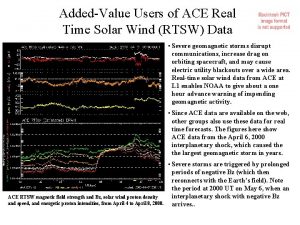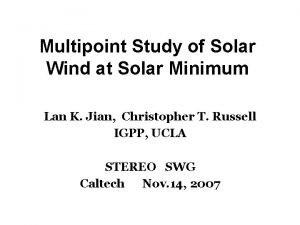AddedValue Users of ACE Real Time Solar Wind



- Slides: 3

Added-Value Users of ACE Real Time Solar Wind (RTSW) Data • Severe geomagnetic storms disrupt communications, increase drag on orbiting spacecraft, and may cause electric utility blackouts over a wide area. Real-time solar wind data from ACE at L 1 enables NOAA to give about a one hour advance warning of impending geomagnetic activity. • Since ACE data are available on the web, other groups also use these data for real time forecasts. The figures here show ACE data from the April 6, 2000 interplanetary shock, which caused the largest geomagnetic storm in years. ACE RTSW magnetic field strength and Bz, solar wind proton density and speed, and energetic proton intensities, from April 4 to April 8, 2000. • Severe storms are triggered by prolonged periods of negative Bz (which then reconnects with the Earth’s field). Note the period at 2000 UT on May 6, when an interplanetary shock with negative Bz arrives. .

Dst Index Predictions Using RTSW Data from ACE • The Dst Index measures the magnetic perturbation at the Earth's surface due to geomagnetic storms. • Predictions of the Dst index can be obtained from the solar wind and interplanetary magnetic field conditions. ACE RTSW data can be used to forecast both the timing and magnitude of a magnetic storm. The Space Physics Research Group at Berkeley provides this Dst predictor at http: //sprg. ssl. berkeley. edu/dst_index/. If the Pointer is in the red (extreme Dst), a storm is imminent. The Nonlinear Dynamics and Space Physics Group at GSFC provides this Dst prediction (colored lines), compared here with the Quicklook Dst from the World Data Center C 2 in Kyoto. http: //lepgst. gsfc. nasa. gov/nrt_predictions. html

Other Users of ACE RTSW Data • Dynamic modeling of the Earth's bow shock and magnetopause, by Steve Petrinec of the PIXIE/Polar team is shown at left. (http: //pixie. spasci. com/Dyn. Mod/. ) Other examples include: • Predictions of auroral electrojet AE index and geomagnetic Kp index, at Lund Space Weather Center, Sweden. http: //nastol. astro. lu. se/~henrik/spwrealfo. html • The Chandra Science Operations Team uses ACE RTSW data for alerts of large solar proton events which could damage the Chandra CCDs. • Ionospheric forecasting at the University of Alaska and the Arctic Region Supercomputing Center (ARSC). http: //www. pfrr. alaska. edu/~sergei/ • For more examples…see http: //www. srl. caltech. edu/ACE/ASC/related_sites. html





